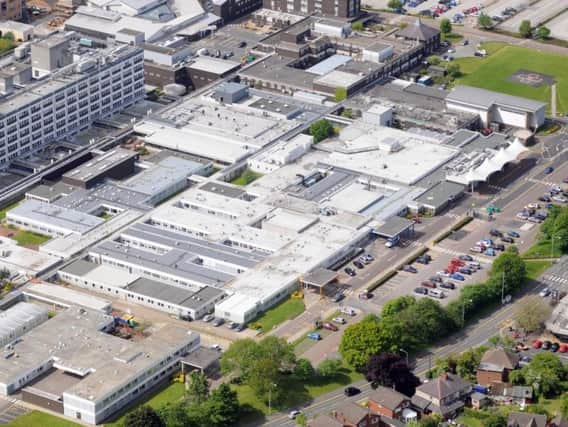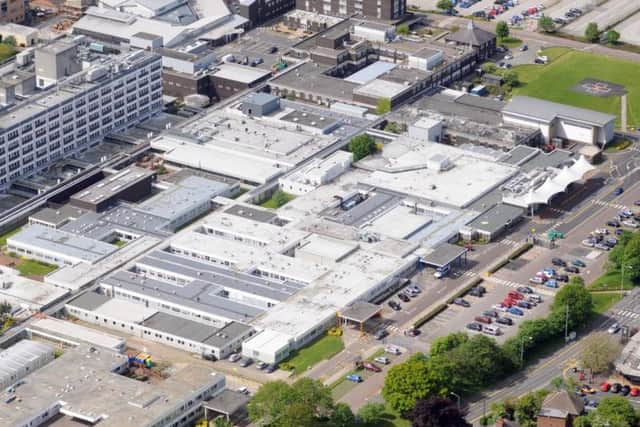Dramatic bed shortage at Preston's hospital leaves patients waiting hours


Twice staff were left with just two free beds amid a shortage of space for patients at the facility on Sharoe Green Lane throughout December.
And the full-up hospital is having a knock-on effect on the A&E department, with almost half of patients waiting more than four hours in the department.
Advertisement
Hide AdAdvertisement
Hide AdNew figures show the city’s hospital had the third worst performing major emergency department in the country in Dec ember.


The hospital was running at 97 per cent capacity throughout December – despite warnings that anything over 85 per cent can lead to delays.
Mark Hendrick, MP for Preston, said: “I am very concerned this is an increasing trend.”
He said years of austerity had led to ward closures and staff shortages.
Advertisement
Hide AdAdvertisement
Hide Ad“The staff are doing as much as they can but the service as a whole needs to fill these vacancies,” he added.
Campaigner Steve Turner, of the Protect Chorley Hospital from Cuts group, said the figures were “absolutely disappointing”.
He added: “This is one reason why we really do need a fully functioning 24/7 A&E at Chorley.”
New figures from NHS England reveal just 58 per cent of patients at A&E were admitted, transferred or discharged within the four-hour target in December.
Advertisement
Hide AdAdvertisement
Hide AdThat was down from 62 per cent in December 2017, despite the number of patients to be seen falling from 5,661 to 4,474.
This winter has seen more patients directed away from A&E to urgent care centres, to relieve the burden on strained medics. The overall proportion of patients seen within four hours, including those at urgent care or walk-in centres, remained steady at 81 per cent.
And amid national concern over a shortage of beds in the NHS, figures reveal RPH was operating at almost full capacity throughout December.
The hospital has 830 “core” beds and can open a small number of escalation beds during busy periods to cope with demand.
Advertisement
Hide AdAdvertisement
Hide AdOn eight days between December 3 and 12, every single core bed in the facility was taken up.
On both December 9 and 12, figures show there were just two free beds in the whole hospital.
Between December 3 and 30, bed occupancy averaged at 97 per cent, never dropping below 86 per cent.
The National Audit Office has previously said occupancy rates over 85 per cent can lead to “regular bed shortages, periodic bed crises and increased numbers of hospital-acquired infections”.
Advertisement
Hide AdAdvertisement
Hide AdMr Turner added: “People have got to be responsible and accountable for fixing this problem. This is about people’s lives.”
David Owen, chairman of the Lancashire-based 38 Degrees NHS support group, said he feared the relatively mild winter so far meant the worst could be yet to come for the region’s hospitals.
He added: “The Government has got to start funding the NHS at the level necessary to meet the demands on it.”
Faith Button, director of performance at Lancashire Teaching Hospitals, said: “Across the whole of our emergency department 81.37 per cent of patients were seen within four hours during December.
Advertisement
Hide AdAdvertisement
Hide Ad“The demand and pressure on the NHS at this time of year is well known and so with our partners across Central Lancashire we have put well developed plans into place to manage the increasing number of people requiring our services. Despite this increased demand, our staff continue to work hard to provide the best possible care for those most in need and we are continually working with our other healthcare system partners to manage this demand as best as possible.”
The trust said a new system to divert patients with more minor conditions away from A&E to more appropriate services was reducing the strain on A&E but meant the waiting times figures were skewed as a result.
Ms Button added: “We have also seen the time taken for ambulance handovers fall dramatically over recent months. The improvements we have made to the emergency department environment as a result of securing £1.9m in national funding, including a new ambulance triage area, will also help contribute towards making sure that those patients arriving by ambulance are seen and assessed by a senior doctor as soon as they arrive.
“We are now in what is usually the most pressured time of year. Cases of flu, other winter bugs and adverse weather conditions can all create extra demand, so some days the pressure on our beds does increase more than others.”
Advertisement
Hide AdAdvertisement
Hide AdAnd she said measures including a new discharge process introduced late last year to help patients leave hospital sooner once they were fit enough “help us to better manage the number of beds we have available at any given time”.
Neil Cosgrove, senior vice secretary of the North West Ambulance Service branch of the Unite union, said members felt the NHS has become “top heavy” with managers and money could be better spent elsewhere.
He added: “The NHS has streamlined hospitals to the extent they haven’t got the capacity to deal with demand.
“The hospital is working damn hard to try and alleviate the problems.”
Advertisement
Hide AdAdvertisement
Hide AdBut he said facilities and beds had been cut back over the years, meaning there was nowhere else to go when the hospital was full.
He said: “You’ve closed Chorley - that emergency department isn’t going to open up so they can’t deal with it.”